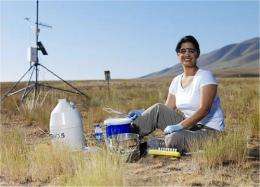Pacific Northwest National Laboratory microbiologist Vanessa Bailey is part of a team that is studying the function of microbial communities in soil.
When it comes to studying microbial communities in soil, the smaller the sample, the better. Only by approaching the scale at which microbes interact and function, the micron scale, can scientists understand how the community works. To that end, scientists at Pacific Northwest National Laboratory assayed sub-millimeter-sized soil aggregates to determine biomass and enzyme potential.
They found that across all enzymes, the smallest macroaggregates had the greatest activity.
Also, the range of enzyme activities observed in all macroaggregates supports their hypothesis that functional potential in soil is not uniform across aggregates, and that both "hot spots" and "cold spots" of activity are measureable; that is, the function they measured was distributed in a patchy fashion. The work is described in the journal Soil Biology and Biochemistry.
The scientists adapted four enzyme assays to single aggregates of soil so they could study habitat-relevant units. This has also enabled them to describe variability in the enzyme potential at the individual macroaggregate level. Measuring the potential activity of an enzyme in soil provides information about the soil's ability to mediate critical reactions such as those associated with decomposition and other ecosystem functions. These ecosystem functions contribute to the soil's resistance and resilience to environmental changes.
Traditionally, soil microbiologists study microbial communities and processes in batch scale; that is several to hundreds of grams. Studying function at the aggregate scale, which is closer to that of microbial habitats, presents greater opportunity to link microbial community structure to function and may reveal more information about soil as a habitat for microbial communities
In turn, increased understanding of microbial interactions in soil opens up myriad possibilities for land management. If scientists can learn how bacteria live and function together, the knowledge can lead to new opportunities for mitigating climate change and greenhouse gas emission or in bioremediation.
Scaling is the key. "Studying soils at the batch scale doesn't show us a microbial community," said PNNL microbiologist Dr. Vanessa Bailey. "The larger the sample, the larger the volume throughout which the microbes are distributed. And as distance between microbes increases, the likelihood of interaction decreases.
"Processes mediated by microbes occur at the micron scale," continued Bailey. "An aggregate that's less than 1 millimeter in diameter, or slightly thinner than a credit card, gets us to where the microbes within are more likely an interacting community rather than a collection of organisms in a single sample."
To assess the functional potential at the macroaggregate scale, which ranges from 250 -1000 micrometers in diameter, the scientists developed a way to assay biomass and enzymes in individual soil macroaggregates. They took ten adjacent soil cores from grassland at the U.S. Department of Agriculture Conservation Field, near Pullman, Washington. They used a sieve to select individual macroaggregates in three size classes: 250-425, 425-841, and 841-1000 micrometers, respectively.
They then measured microbial activity using β-glucosidase enzyme assays and microbial biomass using adenosine triphosphate, or ATP, to link biomass to cellulolytic potential. β-glucosidase is likely the rate-limiting step in cellulose degradation. Its presence is "patchy" at the small scale, meaning that microsite controls may exist that control its production and/or stabilization. Those microsite controls may include the competence of the intrinsic microbial community.
"We hope to eventually link community structure with function in a complex natural ecosystem such as soil," said Bailey. "And from that, we could have the potential to determine if there are biological rules that are constant within these microsites that will help us understand the variability of phenomena in the landscape."
More information: Bailey VL, et al. 2012. "Measurements of Microbial Community Activities in Individual Soil Macroaggregates." Soil Biology and Biochemistry, available online 19 January 2012.
Provided by Pacific Northwest National Laboratory



















